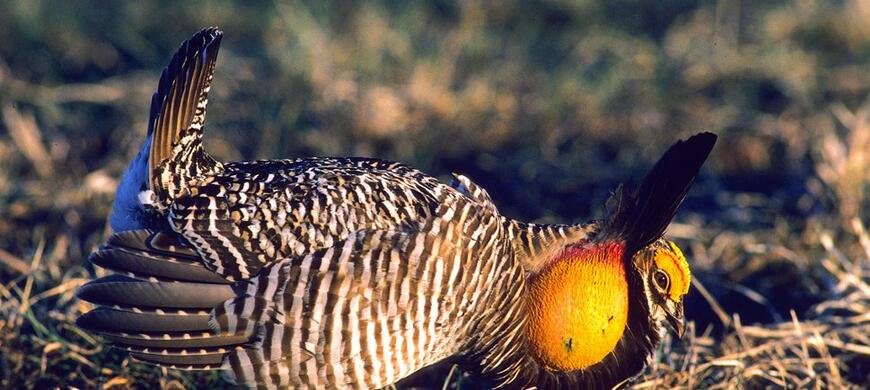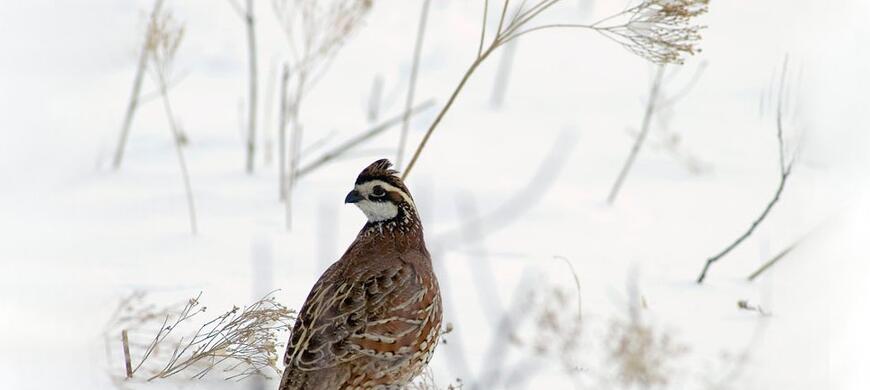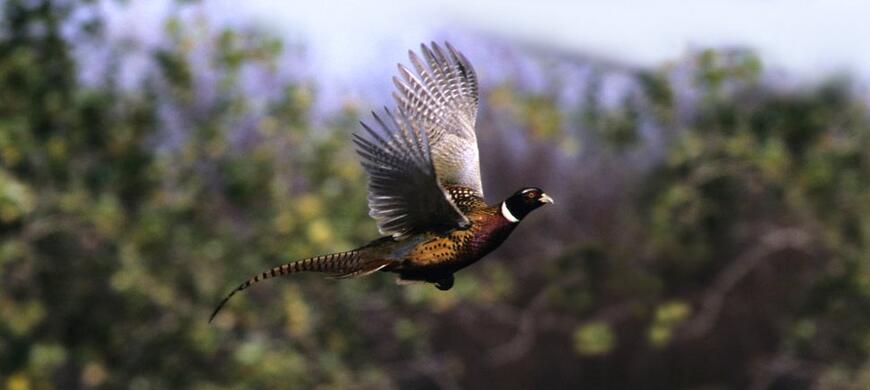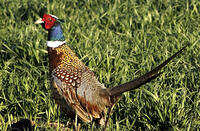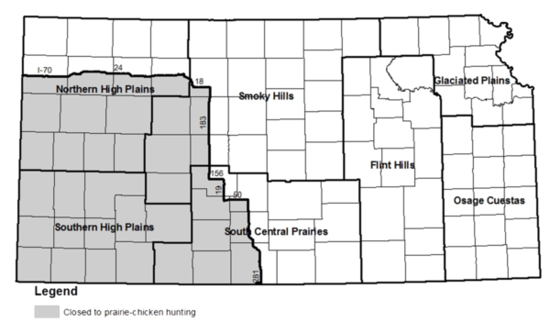Upland Birds
Kansas boasts some of the best upland bird populations in the world. In fact, the largest concentrations of both lesser and greater prairie chickens are found in Kansas. Bobwhite quail still thrive throughout much of the state, and in the far southwest corner, scaled quail can be found. Although not native, the ring-necked pheasant has become a fixture to much of the Kansas landscape. This variety and abundance of opportunities has made Kansas one of the more popular destinations among bird hunters worldwide. All upland bird populations fluctuate annually according to weather and habitat conditions. To assist hunters with travel plans, KDWPT staff use a variety of surveys to assemble the Upland Bird Forecast, which is published each September. The forecast provides up-to-date information about bird numbers around the state.
Forecast Factors
Two key factors impact the availability of upland game during the fall hunting season: the number of breeding adults in the spring and the reproductive success of that population. Reproductive success encompasses both the number of nests hatched and chick survival rates. For pheasant and quail, annual survival rates are relatively low; therefore, the fall population relies more heavily on summer reproduction than spring adults. While reproductive success remains the primary population regulator for prairie chickens, higher adult survival also helps sustain hunting opportunities during poor conditions This forecast will discuss the breeding populations and reproductive success of pheasants, quail, and prairie chickens. Breeding population data were gathered through spring calling surveys for all three species. Data on reproductive success were collected via late-summer roadside surveys for pheasants and quail, which quantify the number of adults and chicks observed. Assessing the reproductive success of prairie chickens is more challenging, as they do not typically associate with roads in the same way as pheasants and quail.
Kansas experiences a significant rainfall gradient, with average annual rainfall exceeding 50 inches in the far east and dropping below 16 inches in the far west. The amount and timing of rainfall are crucial for the reproduction of upland birds. In western Kansas, wet years generally improve available cover and increase insect availability for chicks. Conversely, in the east, dry years are often more favorable, as heavy rains during spring and summer can hinder the survival of nesting birds and young chicks. Above-average summer rainfall in 2023 across much of western Kansas greatly enhanced nesting cover heading into spring 2024. Continued adequate rainfall into mid-summer across the west provided good nesting and brooding conditions. As a result, production was significantly better than seen in recent years.
| Season | Open Dates | Daily Bag (Possession) | Open Areas |
|---|---|---|---|
| Youth Pheasant | 2-3 Nov | 4 (8) | Statewide |
| Youth Quail | 2-3 Nov. | 8 (16) | Statewide |
| Pheasant | 9 Nov. – 31 Jan. | 4 (16) | Statewide |
| Quail | 9 Nov. – 31 Jan. | 8 (32) | Statewide |
| Prairie Chicken | 15 Sep. – 31 Jan | 2 (8) | Prairie Chicken Hunting Unit * see regulations for closed zone |
Pheasant – Pheasant populations have improved significantly across Kansas due to better nesting cover and favorable weather. Chick survival rates were high, thanks to an abundance of arthropods providing ample food, particularly grasshoppers. The high plains regions in the western third of the state saw the most notable increases, with some areas experiencing densities not seen in some time. The central prairie regions also saw improvements, though not to the extent of the high plains. While populations had been depressed by drought, the unexpected increases are promising. However, more time is needed for a full recovery. This year, acres enrolled in the Conservation Reserve Program (CRP) were again released for emergency cattle forage across most of the state. So far, CRP land hasn’t been as heavily used as in previous years, but it could still impact hunting success. Overall, pheasant hunting is expected to improve, and harvest numbers should rise. The best hunting opportunities will be in northwest and southwest Kansas.
Quail – Kansas continues to support above-average quail populations, with statewide spring densities remaining similar to last year. The summer brood survey showed significant increases in production. However, while quail numbers increased, the gains were not as large as those seen in pheasant populations. This is likely due to later peak nesting and less favorable weather later in the summer. Compared to previous years, the highest quail densities have shifted south. The Smoky Hills in north-central Kansas, which had the highest densities for several consecutive years, now has lower numbers than other major quail regions. The highest quail densities were observed in the Flint Hills and Southern High Plains, though good populations were reported across much of the southern half of the state. Kansas maintains one of the strongest quail populations in the country, and with abundant public access, the state is expected to have one of the highest quail harvests in the country. The best hunting opportunities will be in the southern half of the state, with quality spots scattered across other regions.
Prairie Chicken – Kansas is home to both greater and lesser prairie chickens, which require landscapes dominated by native grass with a few scattered grain fields. Greater prairie chickens are primarily found in the tallgrass and mixed-grass prairies of the eastern third and northern half of the state. Their numbers and range have recently expanded in the northwestern portion of Kansas, while declining in the eastern regions. Although prairie chickens are typically more stable than other upland bird species, prolonged drought conditions have reduced production, resulting in lower spring densities. Improved rainfall this year likely helped with production, but the areas with the highest remaining populations of prairie chickens did not recover as well as others. Despite this, hunting opportunities this fall will be best in the Smoky Hills region, where populations have remained most stable and public access to suitable habitat is more abundant.
The Southwest Prairie Chicken Unit, where lesser prairie chickens are found, remains closed to hunting. Greater prairie chickens may be harvested in the Greater Prairie Chicken Unit, with a daily bag limit of two birds. All prairie chicken hunters are required to obtain a Prairie Chicken Permit, allowing KDWP to better track hunter activity and harvest for management purposes.
Public Land: 12,849 acres
WIHA: 369,728 acres
Pheasants – This region saw significant improvements in roadside survey results this year. The High Plains has long been known for its pheasant populations but has experienced several consecutive years of below-average numbers. This year, dramatic population increases were observed across much of the region. Although many areas started from depressed populations, the increases were substantial enough to create good densities overall. Densities remained lower along the I-70 corridor, where the landscape is primarily cropland. Ample hunting opportunities exist as you move away from the interstate into mixed habitats, where higher densities were recorded. Since milo is less common in this region, hunters should target good cover such as waste grain or quality CRP adjacent to food sources.
Quail – Quail populations are limited and are typically harvested opportunistically by pheasant hunters. Weather patterns have facilitated population expansion in areas with suitable habitat, providing hunters with an additional opportunity in recent years. Summer roadside surveys indicated an increase in quail densities this year, particularly in the northeastern counties of the region, where hunting opportunities will be best.
Prairie Chickens – Prairie chicken populations recently expanded in both numbers and range within the region; however, drought conditions have significantly reduced spring densities. Only portions of this region are open to hunting (see map for unit boundaries). Production in the region was likely good this year based on upland bird production, which should enhance hunting opportunities compared to last year. Within the open areas, the best hunting should be found in counties along the Nebraska state line in native prairies and adjacent CRP grasslands.
Public Land: 106,720 acres
WIHA: 295,252 acres
Pheasants – This region showed slight improvement in the roadside survey but remains below the long-term average. Recovery from drought conditions has not been as rapid as in other parts of the state, limiting pheasant recovery, particularly in the north-central areas where densities have declined. Despite this, much of the region experienced similar increases to other areas of the state, leading to overall improvement. Quality hunting opportunities exist across much of the region, with the Smoky Hills likely to be a major contributor to this year’s overall harvest due to its size and accessibility. The southern and southwestern portions of the region will offer the best opportunities.
Quail – This region enjoyed several years of well above-average quail densities but has gradually declined since 2018, resulting in below-average fall densities this year. Spring densities were slightly reduced after poor production in 2023. While production improved this year and helped maintain populations, it was not enough to offset last year’s reductions. Although the region has lower fall densities than other major quail regions, it still offers a large area and hunting opportunities. Similar to pheasants, quail densities appear to be highest in the southern and southwestern portions of the region, where some improvements were noted.
Prairie Chickens – Prairie chicken hunting opportunities in the region are expected to remain fair. Production likely improved due to better precipitation, though conditions were not as favorable as in other regions. The area has maintained relatively stable densities and offers the greatest access in the state to suitable habitat. Greater prairie chickens are found throughout the Smoky Hills, where large areas of native rangeland are interspersed with cropland. The best hunting is expected in the central portion of the region, though several other areas support huntable densities of birds. The southwestern portion of the region falls within a closed zone (see map for unit boundaries).
Public Land: 51,469 acres
WIHA: 67,831 acres
Pheasants – Pheasant habitat in this region, including grass waterways and similar areas, has continued to decline. Pheasants were not recorded on any survey routes this year, and densities remain typically low, especially compared to other areas in central and western Kansas. Hunting opportunities will be poor, with pheasants found only in isolated pockets of habitat, primarily in the northwestern portion of the region or in areas specifically managed for upland birds.
Quail – Regional quail densities remain above average, although they have shifted within the region since last year. Previously, densities were more consistent throughout the area. This year, increases were observed in areas near large blocks of rangeland in the western portion, while the eastern part of the region, characterized by mixed cropland and woodland habitats, saw declines. With limited nesting and roosting cover throughout much of this region, targeting areas with or near native grass is essential for successful hunting.
Prairie Chickens – Very few prairie chickens are found in this region, and hunting opportunities are limited. The best chances for success are in the western edges of the region along the Flint Hills, where some large areas of native rangeland still exist.
Public Land: 109,883 acres
WIHA: 33,459 acres
Pheasants – This region is outside the primary pheasant range, resulting in very limited hunting opportunities. Pheasants are occasionally found in the northwestern portion of the region, but at very low densities.
Quail – Quality hunting opportunities should exist this year, particularly in the southwestern portion of the region. Roadside estimates indicated a slight increase this year; however, this was primarily due to improvements in the southern half of the region, which were offset by declines in the northern half. Some areas that previously experienced depressed populations remain low despite the overall improvement. Good densities of quail were observed in the southwest, especially adjacent to the Flint Hills. Hunting in this area is expected to be greatly improved, although much of the region will still have poor opportunities. Hunters should focus on grasslands that support quail or areas specifically managed for upland birds.
Prairie Chickens – Greater prairie chicken populations have consistently declined in this region over the long term. Fire suppression and the loss of native grassland have gradually reduced suitable habitat. While hunting opportunities are limited, prairie chickens can occasionally be found in large blocks of native rangeland, primarily along the edges of the Flint Hills.
Public Land: 196,901 acres
WIHA: 88,415 acres
Pheasants – This region is on the eastern edge of Kansas’ primary pheasant range and offers limited hunting opportunities. Pheasant densities have always been low in the Flint Hills, with the highest numbers found on the western edge of the region. Roadside counts decreased this year, with pheasants recorded on only one survey route. Given the limited densities and observed declines this year, hunting opportunities are expected to be limited. The best chances for success will be in the northwest portion of the region along the Smoky Hills.
Quail – The Flint Hills had the highest regional densities of Bobwhite from the summer brood survey. Reduced production last year resulted in slightly reduced, but still strong spring densities. After a dry year last year limiting habitat regrowth, burning was below average this year leaving more nesting cover this summer. Quail were able to take advantage of this cover and improved conditions to see considerable improvements across the southern Flint Hills, where the highest densities will be found. The northeastern portion of the region saw declines.
Prairie Chickens – The Flint Hills is home to the largest intact tallgrass prairie remaining in North America and has served as a core habitat for greater prairie chickens for many years. However, management practices involving too little or too much prescribed burning have gradually degraded habitat quality, leading to declining prairie chicken numbers. Burning was below average in 2024, which may have improved nesting cover. Production was likely better in the southern Flint Hills. Hunting opportunities throughout the region are expected to remain similar to last year.
Public Land: 41,125 acres
WIHA: 57,585 acres
Pheasants – Roadside survey estimates showed significant improvements across the region. While densities in the central part may have declined slightly, the majority of survey routes reported major improvements, with three routes observing pheasants that were absent last year. Although pheasant densities were low last year, these improvements are encouraging and will provide more consistent hunting opportunities throughout the region, though they did not lead to high densities overall. The largest pheasant populations will be found in the northwestern counties adjacent to the Smoky Hills.
Quail – Quail densities in this region experienced slight declines but remain relatively strong overall. Areas dominated by prairie saw improvements, while the central portion, which is more cropland-focused, experienced declines. The intermixing of quality cover types generally provides more consistent opportunities across the South-Central Prairies compared to other regions. The best hunting opportunities this year will be in the Red Hills, particularly along the Oklahoma border.
Prairie Chickens – The extensive rangeland areas in this region are largely closed to prairie chicken hunting (see map for unit boundaries). Prairie chickens are found in very limited areas elsewhere in the region at low densities. Encounters are unlikely but possible in the few remaining large tracts of rangeland in the northeastern portion of the region.
Public Land: 116,821 acres
WIHA: 143,071 acres
Pheasants – Similar to the Northern High Plains, this region experienced significant improvements this year. Last year, it was extremely depressed, recording the lowest regional densities among all major pheasant regions. Late summer rains in 2023 greatly enhanced nesting cover, and the ideal summer brooding conditions led to improved production, resulting in regional densities comparable to those observed in the Northern High Plains. CRP lands comprise a large percentage of the grassland in the region, and all counties were released for emergency CRP use again this year, which will likely impact the availability of huntable cover. Good hunting opportunities should exist across most of this region, particularly in areas with remaining high-quality CRP cover.
Quail – The quail population in this region is highly variable and dependent on weather conditions. Improved precipitation this year positively affected roadside estimates in the area. The highest quail densities are found along riparian corridors. Given this year’s roadside estimates, hunters should also have success targeting other woody structures or old homestead sites away from riparian areas. Scaled quail can also be found in the sand sage prairies within this region, but they make up a small proportion of the total quail population and have been depressed for the last couple of years.
Prairie Chickens – Prairie chicken hunting is closed in this area.
Conservation Reserve Program
Under the 2018 Farm Bill, the Conservation Reserve Program (CRP) acreage cap has gradually increased each year. Currently, Kansas has approximately 1.96 million acres of CRP statewide. However, more than 486,000 acres of this total consist of grassland CRP, while traditional CRP acres continue to decline. This decline is largely attributed to lower rental rates combined with high commodity prices. Alongside the loss of acreage, the quality of habitat on the remaining acres is expected to be reduced. A total of 98 counties in Kansas have been released for emergency haying and grazing of CRP. A large portion of properties in Kansas' Walk-in Hunting Access (WIHA) and iWIHA programs include CRP land, and expirations/haying can reduce habitat quality or even exclude properties from the program. For 2024, Kansas' WIHA/iWIHA program has nearly 1.05 million acres enrolled. Atlases for these programs are available online at ksoutdoors.com/wiha and at locations where Kansas hunting and fishing licenses are sold.
Kansas has almost 1.7 million acres open to public hunting (Wildlife Areas and WIHA combined). There are more than 50 million acres of private land that also provide opportunity where permission can be obtained.











